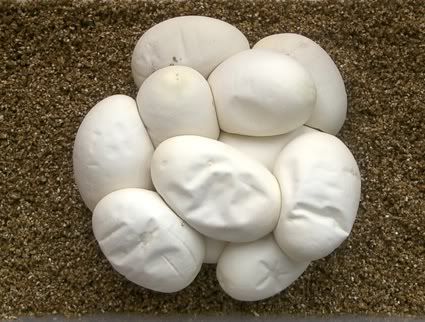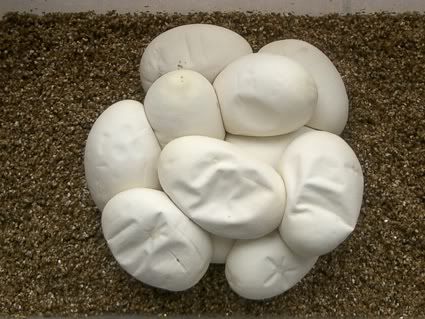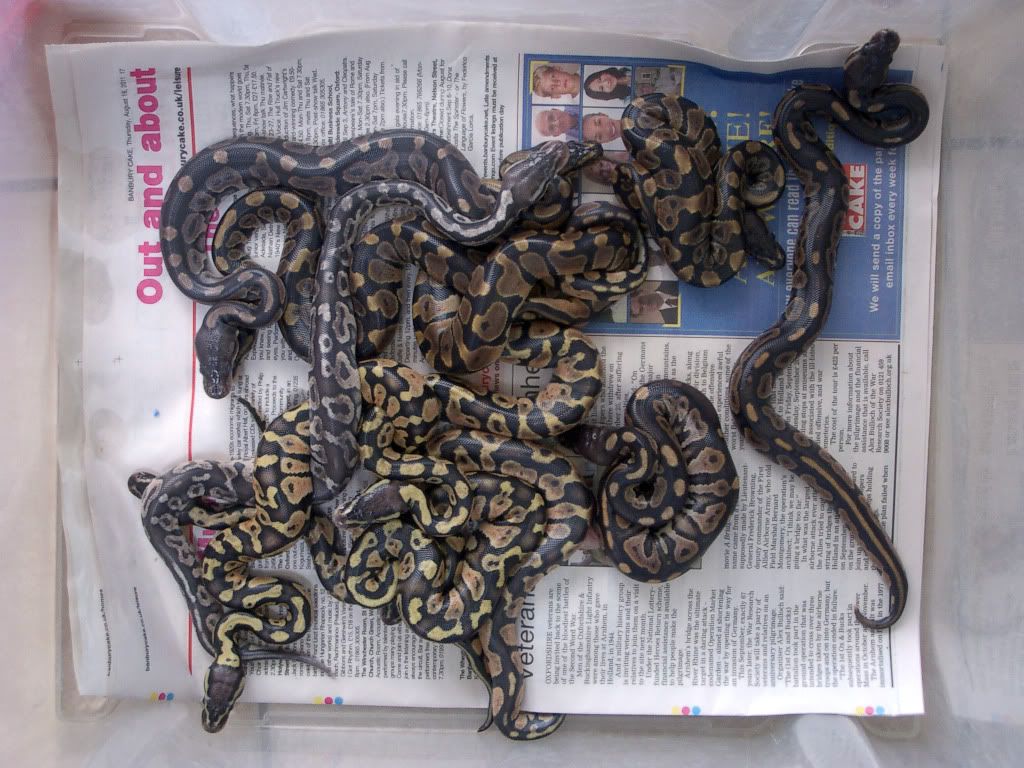| T O P I C R E V I E W |
| Eleanor |
Posted - 19/07/2011 : 15:52:05
Hi all, this is my first post here, though I've been around on other forums - not much though, because I'm an unsociable so-and-so. This is a nice forum.
I've got my first ever clutch of eggs and I'd appreciate some advice. There are 11 of them!  Unfortunately they're all stuck together. Unfortunately they're all stuck together.
I'm incubating them at 30 degrees on damp vermiculite. I measured the humidity in there today, with a digital probe so I trust the measurement, and it was over 98%. BUT the eggs on top of the heap are dented, and they are getting slightly more dented. I don't have the experience to know whether I should worry about this, and if so, what I can do. Can anyone give me some advice?
On the 16th:

Today:
 |
| 20 L A T E S T R E P L I E S (Newest First) |
| Kelfezond |
Posted - 20/09/2011 : 22:36:22
Wonderful, great work! |
| scooterboy71 |
Posted - 20/09/2011 : 22:32:42
 congratulations congratulations |
| hodgie |
Posted - 18/09/2011 : 21:53:01
Well done. |
| Royalbob |
Posted - 18/09/2011 : 14:53:58
Big Congrats |
| n/a |
Posted - 16/09/2011 : 11:48:51
Aww! Babies!! They are LOVELY!! again CONGRATSSSSSS!!!  |
| Eleanor |
Posted - 16/09/2011 : 11:32:35
quote:
Originally posted by BurnedAtTheStake
Congrats! Eleven?? I thought they only had 6 or 7???
So did I lol!
SNAKE HEAP

A couple of them are in shed now, including the pewter. |
| Jayde |
Posted - 15/09/2011 : 21:27:14
PICTURES!!!!!!!!  |
| n/a |
Posted - 15/09/2011 : 17:55:22
Congrats! Eleven?? I thought they only had 6 or 7???
Hadn't seen this thread before and read with interest. I'm so envious lol. And congrats on the pewter too. |
| Eleanor |
Posted - 15/09/2011 : 17:10:09
Update: all 11 eggs hatched, so thanks for the advice. I heaped a bit of damp vermiculite on top of the topmost eggs without covering the bottom ones at all, and that seemed to work well.
Only 1 pewter out of the 11 though! |
| Jayde |
Posted - 19/07/2011 : 19:55:50
Yes, sorry made it sound like you would cover them completely.
I tired to find a picture of one of my old clutches as I used to document them through a diary and with pics at various stages.
This is one of the better pictures I found on google to try and explain what I mean (without you having separated the eggs, obviously!)

The eggs have a good coverage of vermiculite to keep them hydrated, and a large enough surface area to allow a good intake of oxygen.
Personally, if the damp paper towel method doesn't work to well, I'd cover the caved eggs with a small / thin layer of vermiculite for a couple of days and note the affects. If there is an improvement, then repeat for another 2 days, making sure the vermiculite stays damp enough for the eggs to regain their moisture and hydrate. They may not 'pop out' from their caved looked entirely but any improvement is good. Then its up to you whether you want to gently sweep the vermiculite off, or leave it there until hatch day ensuring you keep it damp (best done through light misting in my experience). Do not leave it there and let it dry out If you do then the vermiculite will start to draw moisture out of the egg and you will be back to square one of having dehydrated eggs!!
The best way I incubated my clutches was before moving the eggs into the incubator, I used to scoop a small "ditch" in the vermiculite and almost nestle my eggs in there, which would mimic a natural lay site. It provided them with a snug enough area to stay well hydrated but also a good airflow meaning they took in sufficient oxygen.
Hope they keep going strong, would be nice to see some beautiful little pewters come out ;) |
| reptiledanny |
Posted - 19/07/2011 : 19:09:16
best not to cover the eggs all the way to the top of the eggs as the bottom ones will not have alot of oxygen around them. this is why some people use a substrateless bottom, or use sim containers, where the eggs are not in contact with substrate so they have a higher % of oxygen coverage making the incubation times quicker |
| Eleanor |
Posted - 19/07/2011 : 18:23:00
Sorry anatess - edited while you were replying. The eggs were already quite dented when I first looked at them and they'd have dried out fast where they were. |
| anatess |
Posted - 19/07/2011 : 18:16:08
quote:
Originally posted by Eleanor
She laid them under a ceramic pot which was placed right under the heat bulb - I really didn't fancy leaving them there. I thought she was so far off laying that, like an idiot, I didn't even have a nice moist laying container in there for her. Won't make that mistake again!
The momma snake will choose the best spot for the eggs in the viv. If your viv is not ideal for the momma snake, then yes, you will have problems. But, if your viv is the ideal set-up for a royal, then maternal incubation in the same viv is not a problem. All you need to do is raise the humidity to around 70ish (like how you would do it on shed cycles). A laybox is not necessary. I had a laybox last year and the snake didn't even bother to use it.
|
| anatess |
Posted - 19/07/2011 : 18:11:48
quote:
Originally posted by Eleanor
A more general question here about keeping eggs hydrated. Should all of the eggs always have some contact with the substrate (or moist paper towel, etc) to be sure of staying hydrated? If they do that's where I went wrong. I'd thought from what I'd read that high humidity was enough. Reading is all very well, but there's nothing like experience.
In the future I will be more prepared, as Jayde suggests, with extra vermiculite handy.
No. A lot of people have substrate-less incubators like this:
http://www.youtube.com/watch?v=fe9w3cmdkLA |
| Eleanor |
Posted - 19/07/2011 : 18:11:48
She laid them under a ceramic pot which was placed right under the heat bulb - I really didn't fancy leaving them there, since they were already dented.
I thought she was so far off laying that, like an idiot, I didn't even have a nice moist laying container in there for her. Won't make that mistake again!
|
| anatess |
Posted - 19/07/2011 : 18:08:34
For future reference...
If you don't have a proper incubator, it is always better to leave the mother with the eggs in a regular viv than trying to move the eggs out into a questionable incubator.
Just my 2 cents. |
| Eleanor |
Posted - 19/07/2011 : 18:07:07
A more general question here about keeping eggs hydrated. Should all of the eggs always have some contact with the substrate (or moist paper towel, etc) to be sure of staying hydrated? If they do that's where I went wrong. I'd thought from what I'd read that high humidity was enough. Reading is all very well, but there's nothing like experience.
In the future I will be more prepared, as Jayde suggests, with extra vermiculite handy. |
| Eleanor |
Posted - 19/07/2011 : 17:33:15
The ceramic heating the viv is statted, yes, but I'm keeping an eye on the conditions inside the egg tub all the same. I'm trying the paper towel method right now since its quick and easy. I'll keep a close eye on it. If it dries out very quickly then I suppose that in itself will be a good indication that there's a problem with the set up. |
| Jayde |
Posted - 19/07/2011 : 17:15:44
The bottom ones should be fine, as you wont be adding any more water to the vermiculite they are already placed on.
I used to mix some in a separate bowl and add where needed, meaning you don't even need to cover the edges of the bottom eggs if you don't wish too.
As long as the vermiculite isn't dripping and there isn't a huge build up of condensation inside the box (it should be very slight, if at all tbh) then they will be fine.
I can't disagree with the paper towel idea, although it can stick to the eggs, if not kept properly moist, which then means you may not be able to remove it without causing damage.
I've never known a ceramic bulb to be used for heating, so I'm not really sure if there are any potential adverse affect that it could cause, as long as the incubating box isn't directly under the heat source. You've said you are remaining at consistent temperature and humidity, so I would say this is the main concern. Is it connected to a thermostat to help regulate the temperature or are you doing that manually?
|
| Eleanor |
Posted - 19/07/2011 : 17:00:30
Thanks for the advice and welcome. The parents are cinnamon and pastel, and the eggs quite new.
They are in a tub with just a small amount of ventilation in the lid, inside a vivarium which is heated with a ceramic bulb - the viv was all I had handy when the eggs came unexpectedly early. I was going to construct something else, and perhaps I still should, but the temperature and humidity inside the egg tub are very constant with this set up, and since the humidity is so high already I can't expect to increase it with a different set up.
So I should cover them more. If I bury them enough for some of the vermiculite to be touching the top eggs, the bottom ones will be almost or completely covered - could this harm them?
The advice about a moist paper towel seems sensible too, since it will leave the bottom eggs as they are and I can change it if necessary and also check the eggs without moving them. |

